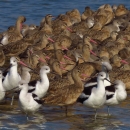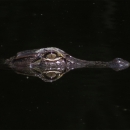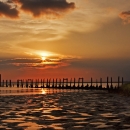About Us
The Refuge is comprised of two islands and two mainland tracts totaling approximately 12,492 acres. Popular recreational opportunities include fishing, hunting, wildlife viewing, hiking, bicycling, kayaking, and nature photography. Surrounded by Outstanding Florida Waters, the Refuge is an important stop-over point along the Gulf coast for neotropical migratory birds and a haven for threatened and endangered species. In addition, St. Vincent NWR serves as a breeding site for endangered red wolves.
Our Mission
“…to manage and preserve the
natural barrier island and associated native plant and animal communities.”
Our History
Title chain for St. Vincent Island
The lands and water that comprise St. Vincent NWR have a rich history. Humans have used the area's natural resources in various ways for thousands of years in order to survive. Early Native Americans lived off the land and waters prior to the arrival of European colonists who settled in the area. It is believed that Apalachicola River Indians first came in contact with Europeans during Narvaez expedition of 1528. During the Spanish mission to the area around 1633, Franciscan Friars named St. Vincent Island. Around the early 1700s, James Moore, British Governor in Charleston, transported thousands of Indians from Apalachee and Apalachicola River countries to a town on the Savannah River (Chapel, unknown). However, around the mid-1700s, the Creek Indians moved into the area. Also the Seminoles, seceders from the Creeks, occupied the area. Up until the Port of Apalachicola was established in 1822, land around the Apalachicola area was occupied by Native Americans. As the Native Americans were forced from the area, they left behind shell middens (mounds) that served as religious and burial sites throughout the area, including the Refuge.
William Panton, John Leslie, and Thomas Forbes owned Panton, Leslie, and Company, a large and prosperous merchant business that would later become known as John Forbes and Company. They received 1,200,000 acres (between Apalachicola and St. Marks River, including St. Vincent Island) from the Creek Indians in 1804, known as the Forbes Purchase. When the U.S. Government acquired Florida in 1819, the land purchases were in question. In 1835, the U.S. courts made the final decision on the land and by that time it was owned by Colin Mitchel of the Apalachicola Land Company.
In 1858, Colonel Robert J. Floyd, an Apalachicola lawyer, appeared to be the first individual owner of St. Vincent Island. His son, Gabriel Floyd, married Sarah Gorrie, daughter of Dr. John Gorrie. During the Civil War, an earthen fort known as Fort Mallory existed on St. Vincent Island. After his death, St. Vincent Island was sold at public auction to Colonel “Captain” George Hatch for $3,000 (in 1868). Captain Hatch was a banker and democrat mayor of Cincinnati, Ohio. Hatch died on the island in 1875. Hatch's wife then sold 10 acres of the island to the U.S. Government for a lighthouse site. The rest of the property was sold to Brigadier General Edward P. Alexander (a commander of artillery in the Army of Northern Virginia during the Civil War and president of the Georgia Central Railroad) and his South Island Company on June 12, 1890.
Dr. Raymond V. Pierce purchased the island from Alexander in 1907 for $12,500. Pierce from Buffalo, New York, was a successful doctor and medicine man. From 1908 to 1909, R.V. Pierce spent close to $50,000 developing the island. He built 30 miles of roads/pathways, cottages, barns, dams, and sluice gates for duck ponds and waterways. He imported sambar deer (e.g., large dark brown, 400- to 600-pound deer native to southern Asia). St. Vincent Island was known as a productive cattle ranch with the herd reaching over 400 head. Dr. R.V. Pierce died in 1914. His son, Dr. V.M. Pierce, managed the Pierce Estate. The island was sold in 1925 to Vernon Price-Williams, a Miami land-boom speculator. He then sold the property in 1927 to Big Four Investment Company; however, the Pierce Estate had not received payment for the land. After a long controversy over ownership and title, the island was sold in December 1932 at public auction at Franklin County Courthouse back to the Pierce Estate. During the 1940s, the first timber was logged off the island via a bridge. The bridge known as the Kenny Mill Bridge linked the island to the mainland (at the Refuge's 14 Mile site).
In 1948, Alfred Lee and Henry Loomis purchased St. Vincent Island for $140,000. The well-known natives of Tuxedo Park, New York, continued with the game preserve, introducing zebras, elands, black bucks, and a variety of exotic birds, including peacocks. During the 1960s, St. Vincent Island was logged again. The timber was removed by barge.
In 1968, The Nature Conservancy (TNC) purchased St. Vincent Island for $2.2 million. The exotic animals were removed from the island except for the sambar deer, feral hogs, a few head of cattle, and a couple of black bucks. Funds from the Migratory Bird Conservation Fund (Duck Stamp dollars) purchased St. Vincent Island on July 9, 1968. Due to the island's unusual features, the Department of the Interior assured the Smithsonian Institution that the island would be available for scientific study after its inclusion in the Refuge System
In 1970, the 86-acre mainland tract (14 Mile site) was acquired from St. Joe Timber Company. The tract was part of a land swap with St. Marks NWR. The intention of the land swap was to create a deep-water access point for operations to St. Vincent Island. However, regulations were established to protect Apalachicola Bay, which disallowed the development of the deep-water access point. The Refuge headquarters was located on the property until November 21, 1985, when Hurricane Kate destroyed the office trailer and other associated buildings.
Pig Island, 46 acres in size, is in St. Joseph Bay, Gulf County. It was transferred from the Bureau of Land Management by Public Land Order 5233, dated July 21, 1972.
The 11 Mile administrative tract was added to the Refuge in 2013. The historic Fry-Conter house in Apalachicola was acquired in 2016 and is now the Refuge office.
The purpose of St. Vincent NWR is to protect and conserve migratory birds in accordance with the following:
"... for use as an inviolate sanctuary, or for any other management purpose, for migratory birds." 16 U.S.C. 715D (Migratory Bird Conservation Act of 1929)
Current management is guided by the mission statement directive: "…to manage and preserve the natural barrier island and associated native plant and animal communities."
Title chain for St. Vincent NWR
- John Forbes and Company - 1804 - From Indians;
- Apalachicola Land Company [Colin and Robert Mitchel, Richard Carnohan, James Innerarity, et al.] - 1828-1835;
- Robert Floyd - 1835-1868;
- George Hatch [Banker and former Mayor of Cincinnati, Ohio] - 1868-1875 (date of death);
- Francis Avery - 1875-1881 [ownership via Hatch's will and as debt payment, minus the dowry right of Elizabeth Josephine Wefing Hatch];
- Elizabeth Josephine Wefing Hatch - 1875-1890;
- Edward P. Alexander [Brigadier General and Commander of Artillery, Army of Northern Virginia] - 1890-1907;
- Pierce Development Company [Dr. Ray Vaughn Pierce (Pierce's Proprieties, Inc., and founder of Invalids' Hotel Surgical Institute. The Institute ran from 1882-1941. It replaced the earlier Pierce's Palace Hotel, which burned in 1881. Despite its name, the hotel was a private hospital and clinic. Attached to the rear of the Institute was the six-story "World's Dispensary," where a number of patent medicines, such as Dr. Pierce's Golden Medical Discovery, Dr. Pierce's Purgative Pellets, etc., were manufactured. These and a number of other medicinal products were available by mail order and in drug stores -1907-1914)]; V. Mott Pierce, M.D. - 1907-1925, 1930-1948; and Franklin D. Pierce - 1907-1925;
- Vernon-Price Williams (Land Speculator, Miami, Florida) - 1925-1927;
- Big Four Investment Company - 1927-1930;
- Pierce Estate - 1930 (tax sale; reconfirmed title in 1932 via public auction) - 1948;
- Henry and Alfred Loomis - 1948-1968;
- The Nature Conservancy – 1968; Fish and Wildlife Service - 1968 - present;
Other Facilities in this Complex
St.Vincent NWR is managed as part of the North Florida Refuges Complex.
The North Florida National Wildlife Refuge Complex encompasses the St. Marks National Wildlife Refuge and the St. Vincent National Wildlife Refuge and associated conservation easements across 13 counties in southwestern Georgia and the Florida panhandle protecting close to 95,000 acres for wildlife. The addition of Lower Suwannee National Wildlife Refuge and Cedar Keys National Wildlife refuges unifies our national wildlife refuges along Florida’s “Big Bend” or “Nature Coast,” which is one of the largest, undeveloped, mostly privately-held coastal areas in the nation.
The Refuge Complex headquarters is located at 1255 Lighthouse Road, St. Marks, FL 32355.




